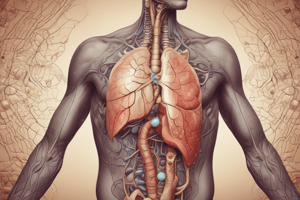Podcast
Questions and Answers
Physiology is the branch of science that deals with the functions of living ______.
Physiology is the branch of science that deals with the functions of living ______.
organisms
The study of ______ refers to the different components of actual, living animals and their interactions.
The study of ______ refers to the different components of actual, living animals and their interactions.
mechanisms
The phenomenon of flashing of lights by fireflies is a way to distinguish them based on their ______ level.
The phenomenon of flashing of lights by fireflies is a way to distinguish them based on their ______ level.
species
The abundance of ______ in gas transport tubules makes the light brighter.
The abundance of ______ in gas transport tubules makes the light brighter.
The hypothetical deductive method is the most widely accepted version of ______.
The hypothetical deductive method is the most widely accepted version of ______.
Physiological properties belong to the normal functions of ______, organs, or body systems.
Physiological properties belong to the normal functions of ______, organs, or body systems.
Testable predictions are made through ______ which involves taking a general explanation and making a specific testable prediction.
Testable predictions are made through ______ which involves taking a general explanation and making a specific testable prediction.
The ______ is the basic/smallest unit of life capable of carrying out different processes associated with life on Earth.
The ______ is the basic/smallest unit of life capable of carrying out different processes associated with life on Earth.
According to the cell theory, cells are capable of ______ and repair damages.
According to the cell theory, cells are capable of ______ and repair damages.
Eukaryotic cells are found in ______ and plant cells, whereas prokaryotic cells are found in bacterial cells.
Eukaryotic cells are found in ______ and plant cells, whereas prokaryotic cells are found in bacterial cells.
The process of change by which an organism becomes better suited to its environment is known as ______.
The process of change by which an organism becomes better suited to its environment is known as ______.
Physiological, biochemical, or anatomic changes within an individual animal during its life that result from chronic exposure to new environmental conditions is known as ______.
Physiological, biochemical, or anatomic changes within an individual animal during its life that result from chronic exposure to new environmental conditions is known as ______.
Flashcards are hidden until you start studying




